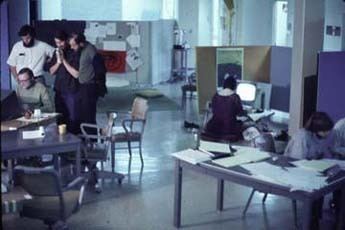Type Private | Founded 1960s (1960s) | |
 | ||
Industry Computer softwareComputer hardware | ||
SRI International's Augmentation Research Center (ARC) was founded in the 1960s by electrical engineer Douglas Engelbart to develop and experiment with new tools and techniques for collaboration and information processing.
Contents
The main product to come out of ARC was the revolutionary oN-Line System, better known by its abbreviation, NLS. ARC is also known for the invention of the "computer mouse" pointing device, and its role in the early formation of the Internet.
Engelbart recruited workers and ran the organization until the late 1970s when the project was commercialized and sold to Tymshare, which was eventually purchased by McDonnell Douglas.
Beginnings
Some early ideas by Douglas Engelbart were developed in 1959 funded by the Air Force Office of Scientific Research (now Rome Laboratory). By 1962 a framework document was published.
J. C. R. Licklider, the first director of the US Defense Department's Advanced Research Project Agency (DARPA) Information Processing Techniques Office (IPTO), funded the project in early 1963. First experiments were done trying to connect a display at SRI to the massive one-of-a-kind AN/FSQ-32 computer at the System Development Corporation in Santa Monica, California.
NASA funding
NASA provided major funding through Robert Taylor in 1964. A custom graphical workstation was built around a commercial computer, the CDC 160A, and a CDC 3100, which handled a single user at a time. In 1965 Taylor became IPTO director, which increased the funding. In 1968 an SDS 940 computer running the Berkeley Timesharing System allowed multiple users.
The project was first called ARNAS after the sponsors. For a few years it was then called the Augmented Human Intellect Research Center, which got shortened to the Augmentation Research Center around 1969.
The Mother of All Demos
In December 1968 in a 90-minute session at the Fall Joint Computer Conference, Engelbart and his team presented their work in a live demonstration, including real-time video conferencing and interactive editing in an era when batch processing was still the paradigm for using computers. This was later called "the Mother of All Demos".
Sale to Tymshare
The technology was sold to Tymshare in 1977, with 20 members of the former SRI group becoming Tymshare employees. Only about three or four people were left to continue the NIC, although this group grew quickly along with the Internet. Jon Postel left in 1977 to join the Information Sciences Institute. A number of early participants moved on to careers at Xerox, Hewlett-Packard, Apple Computer, Sun Microsystems, and other leading computer companies.
Books about ARC
The complex story of the rise and fall of ARC has been documented in a book by sociologist Thierry Bardini. From the perspective of the 1960s counter-culture revolution, John Markoff, in his book What the Dormouse Said, also follows Englebart's persistence in creating ARC as not only a collection of talented off-beat engineers working in direct contrast to the Stanford Artificial Intelligence Laboratory nearby, but also as a sociological experiment that constructed and tested methods for group creation and design.
ARC was also indirectly covered in many other books about Xerox PARC, since that is where many ARC employees later fled to (and brought some of Engelbart's ideas with them). Taylor had founded the Computer Systems Laboratory at PARC in 1970.
